

Your Ultimate Geometry Solver and Math Word Problem AI Assistant

Level up your geometry game with these awesome features!
- Stuck on a word problem? No sweat! Our super-smart AI assistant (powered by cutting-edge tech) will break it down and guide you to the answer, step-by-step.
- See it in action! Watch shapes change and measurements update as you play around - it's like magic!
- Don't memorize, understand! Learn how to solve problems step-by-step, so you become a geometry whiz, not a memorizing machine.
- Show off your work! Save your solutions with all the steps and share them with your friends or teachers.
- Ever wondered how heavy a giant cube of jello would be? This app's weight calculator can handle that (and way cooler shapes too!).
Certified by teachers
Teachers love the Geometry Solver app! It's actually certified by the Educational App Store, which means it's been reviewed by experts and is super teacher-approved. Students can learn with confidence and parents can have their peace of mind.
Awarded by the professionals
Geometry Solver is an award-winning app! It ranked #11 in the 'Mobile Learning in Action' awards for Math category. That means it's one of the best apps out there to help you learn geometry on your phone or tablet.
110+ geometric shapes
Geometry Solver is your all-in-one calculator for shapes! Stuck on a homework problem about circles, squares, pyramids, or even trickier shapes? This app can help you find the perimeter, surface area, and volume of over 110 2D and 3D shapes.
AI Assistant
Say goodbye to the frustration of solving complex math word problems. Our AI assistant, powered by ChatGPT, helps you break down and solve any math word problem step-by-step, making math a less daunting task.
Step-by-step solutions
Don't just get the answer, understand it too! Geometry Solver shows you each step to solve a problem, not just the final answer. It's like having a built-in tutor explaining things clearly.
Export to gallery
Work together, learn together! This app lets you save all your calculations and steps with a single tap. Geometry Solver is a great way to collaborate with friends on homework or study for a test together.
Weight calculator
Pick any shape and choose a material: Is it wood, plastic, or maybe even something crazy like jello? Pick from list or you add your own! The app will tell you exactly how much that shape would weigh.
Live previews
See it change right before your eyes! With Geometry Solver, you can play around with the measurements of a shape and watch it transform instantly. See exactly how changing numbers affects the shape, making it much easier to understand.
Formulas cheat sheet
Forget memorizing formulas! Geometry Solver has a built-in cheat sheet right at your fingertips. Having all the formulas readily available saves you time searching and lets you focus on solving the problem.
How will you benefit?
With over 110 2D and 3D shapes, an AI assistant powered by ChatGPT, step-by-step solutions, and a weight calculator feature, our app is designed to make geometry calculations and math problem-solving a breeze.

Download Geometry Solver
Click on the AppStore link and start learning.
Scan your word problem
And let our AI Assistant solve it for you.
Calculate shape properties
Such as surface area, perimeter, volume and others.
Watch it in action
Still not convinced? Watch a short clip that shows all the major features!
Screenshots
Solve Geometry Problems with Ease: Our Geometry Solver app provides quick and accurate solutions for calculating perimeter, surface area, and volume of over 110 2D and 3D shapes. Whether it's triangles, circles, spheres, or pyramids, we've got you covered.
Enter 3 values to calculate all properties of a triangle

Solve surface area and volume of 3D shapes such as a pyramid

AI assistant powered by ChatGPT will solve your math word problems

Check step-by-step solutions for every calculation

Export your calculations to photo gallery and share it with your friends

Or just use this app to look at the formulas and theorems

Geometry solver for most common shapes such as rectangle

Along with more than 110+ other 2D and 3D shapes

Loved by the users
Join hundreds of thousand users who experienced a significant improvement in their geometry skills.
I can and have done most of these formulas with a calculator over my career but I don’t have to these days. This app is well organized, professional in its appearance and functionality.
Well designed
The list of geometric shapes just keeps growing! Please if you could add a kite shape, that would be awesome. Thank you.
Regular updates
What a great app. Clear and concise. Easy to use and view. Shows formulas. Even links out to wikipedia for further info on a particular shape or exercise. Impressive! Thanks Devs!
This is amazing
Geometry Solver app has been a game-changer for me as a math teacher. It saves me so much time and helps my students understand geometry concepts better. There are frequent improvements and updates.
A game changer
Geometry Solver includes all the shapes I am likely to need. The variables are clearly indicated and a pop-up window is provided indicating the formula applied. It all makes for a very useful app.
Ultimate Geometry Solver
I struggled with math word problems, but the AI Word Problem Assistant in this app has made it so much easier for me. I can finally tackle complex problems with confidence.
AI Assist rules!
Supercharge your math skills with geometry solver.

Math Solver
Geogebra math solver.
Get accurate solutions and step-by-step explanations for algebra and other math problems, while enhancing your problem-solving skills!


Get step-by-step solutions to your math problems

Try Math Solver

Get step-by-step explanations

Graph your math problems

Practice, practice, practice

The 7 Best Android Apps to Help You Solve Math Problems
Got a math problem to solve and need something more powerful than a regular calculator? These Android apps are the solution.
Math is one of the most stressful subjects you can face, and it's understandable. Whether you're good at it or not, solving complex math solutions can be challenging during concepts like calculus or trigonometry. And sometimes, even the fundamental arithmetic problems can give you trouble.
Luckily, there are a ton of apps that can help you solve math problems on your Android phone. Let's look at the best Android apps for improving your math skills.
1. Photomath
Photomath is a popular math solver app that uses augmented reality to solve math problems. It has an intuitive UI while offering plenty of functionality. All you need to do is point your camera at a math problem, or you can import a photo containing the problem from your phone, and it'll solve it for you.
Also, you get a dedicated calculator option that helps you input different problems. While solving them, it provides you with step-by-step guidance with animations and various methods.
Photomath is free to use with limited features. You'll have to subscribe to the Photomath Plus subscription to unlock features like animated tutorials, deeper explanations, hints, and many more. The subscription will cost you $9.99/month or $59.99/year.
Download: Photomath (Free, subscription available)
2. Microsoft Math Solver
Microsoft's Math Solver offers a lot of the same functionality that you get in the Photomath app. It can solve various problems, including trigonometry, algebra, calculus, and word problems.
You can type, scan a handwritten math equation, or import one from your gallery, and you'll get a step-by-step explanation. You can go to history, check back on previously solved problems, and bookmark a specific maths problem if you want to revise it later.
On top of that, you get interactive graphs, daily practice quizzes, and online video lectures that give you a better grip on the topic. It supports multiple languages like Chinese, Hindi, French, Japanese, and many more.
This app also integrates into the Edge browser on the desktop, so you can use Microsoft Edge to solve math problems . The best part about the app is that it's free to use and doesn't contain any ads or in-app purchases.
Download: Microsoft Math Solver (Free)
3. Socratic by Google
Socratic is one of the Android apps from Google that you might have never heard of before. It covers math concepts like algebra, geometry, trigonometry, calculus, and more. Apart from mathematics, it can help with various other topics like biology, chemistry, physics, history, and poetry.
You can scan math equations, word problems, physics questions, or anything else. It'll explain the question along with possible variations of the question and show related videos if it finds any. Given that it's a Google product, you will see most answers from Google search results and YouTube for videos.
The best part about the app is that it's completely free to use and doesn't contain ads throughout the app.
Download: Socratic by Google (Free)
Mathway supports basic to complex mathematics concepts such as trigonometry, algebra, calculus, and many more.
Similar to the other apps on this list, all you've got to do is scan the math problem or type it manually, and Mathway provides you with the answer and explains the steps that led to the solution. When you want to input your equation manually, you get a dedicated keyboard with different functions and symbols.
The app's user interface is minimal and easy to follow. Mathway is free to use but to access features like step-by-step solutions and explanations, you'll need to upgrade to a subscription plan which costs $9.99/month or $39.99/year.
Download: Mathway (Free, subscription available)
5. Camera Math
As the name suggests, Camera Math lets you solve math equations by taking pictures from your camera. It can help you with various math concepts like Calculus, Algebra, Trigonometry, Geometry, and others.
You can point the camera to a math question or import an image from your device to solve your problem. The app uses AI to extract the captured photo information and solve it for you with detailed steps. There's an Ask section in the app where you can ask tutors for help.
Furthermore, you get options like a dedicated calculator, decimal separator, and much more. Camera Math provides a 7-day free trial to decide whether to get the subscription plan, unlocking step-by-step solutions, removing ads, delivering faster solutions, and more. The Premium plan costs you $8.99/month and ranges up to $59.99/year.
Download: Camera Math (Free trial, subscription available)
Cymath is another excellent maths solver app that solves a variety of concepts like statistics, trigonometry, and calculus. Once you enter the app, you'll see a manual input option to enter your question. You can switch to the camera tab to scan it instead of manually entering it.
Cymath has an intuitive and simple-to-use user interface. It's available in four languages other than English. It has a Reference section that includes some basic formulas, rules, and equations that can help you.
Also, you can practice problems based on Pre-Algebra, Algebra, and Calculus in the Practice section, and there's a Blog section with a new problem and its solution every week. Cymath is free to use, but you can opt for the Premium subscription that costs $5/month, gets rid of ads, and provides a detailed explanation of steps, reference material, bookmarks, and more.
Download: Cymath (Free, subscription available)
7. Math Scanner by Photo
Math Scanner has a user interface that makes it simple while focusing on a problem, which you can enter by taking a picture, importing one, or manually entering it through the provided keyboard.
It covers algebra, trigonometry, calculus, statistics, and chemistry. There's also a dedicated section where you can learn these concepts. Furthermore, you can interact with other community members to exchange information. The app contains daily workouts to improve math skills and is available in four languages apart from English.
Math Scanner by Photo is free to use to a reasonable extent. However, you'll need a premium subscription to remove ads and unlock features like unlimited scanning, access to a support team, and more. The subscription plan costs $4.99/week, $9.99/month, or $29.99/year.
Download: Math Scanner by Photo (Free, subscription available)
Get Better at Mathematics
Everyone has unique abilities, so some might excel at maths and others might not. Either way, these apps can help you with your homework and other assignments if you struggle at solving more difficult problems.
Given that online learning is helping students in academics, you can also find some online tools that can help you solve complex math problems.

- Home (current)
- App Categories
- App Reviews
- English Learning Apps for Kids
- Alphabet Apps
- Spelling Apps
- Math Resources
- Multiplication Apps
- Science Apps
- Chemistry Apps
- Physics Apps
- AI Tools Directory
- AI Tools for Education
- Apps for Parents
- Apps for Students
- Augmented Reality Apps
- Computer Science Apps
- Coloring Apps
- Special Education Apps
- Language Learning Apps
- Best of Lists
- Apps for Education
- Best Maths Apps
- Best Apps for Kids
- Free Apps for Kids
- Toddler Apps
- Preschool Apps
- Kindergarten Apps
- EdTech Articles
- Game Reviews
- Brain Training Apps
- Brain Games for Kids
- Word Game Apps
- iPad Games for Kids
- Free Games for Kids
- Website Reviews
Best Websites for Kids
- Preschool Websites
- Math Websites for Kids
- Submit your App
- How we certify apps
- AI Assessment
- Try for free
Best Math Solver Apps for Android and iPhone

Due to the advent of technology, there are apps to solve math problems for smartphones and tablets. These math solution apps make solving complex mathematical problems as easy as clicking a picture and also provide step-by-step instructions explaining how it got to the answer. All you need to do is use your smartphone camera to click a photo of a math problem to solve it.
We have reviewed the best math solver apps to help solve almost any math problem. These math solver apps will help you track formulae and learn algebra, which let you solve equations by simply pointing the camera.
Here is the list of the best math solver apps that can empower you to tackle math problems with ease and efficiency.

1. Photomath
(Android, iPhone, iPad)
Photomath is one of the best math solver apps for solving math problems and solving algebraic equations. Simply point your camera at any piece of paper with an equation or an arithmetic problem and take a picture, and this app will solve any math problems and provides math solutions with detailed steps.
- Scans handwritten math problems accurately
- Recognizes text, symbols, equations
- Huge knowledge base covers vast math subjects
- Detailed step-by-step solutions provided
- Real-life examples explain concepts
- Can struggle with very messy handwriting
- Some limitations recognizing obscure symbols
- Advanced graphing features require paid version
Price: Offers subscription tiers (basic and premium)
Devices: Android, iPhone and iPad

2. Homework Helper: Math Answers
(iPhone, iPad)
Homework Helper is an AI Math Solver that provides instant solutions and step-by-step guidance for all levels of math in topics including geometry, trigonometry, and statistics.
- Accurate optical character recognition and a convenient scanning process
- The additional grammar and translation functions make Homework Solver more flexible
- Entering calculation is quick and easy
Price: Free with in-app purchases
Devices: Android, iPhone and iPad

3. the math solver app
The Math Solver App is an innovative tool designed to assist learners of all levels in solving math problems. It covers a wide range of math topics and offers instant problem-solving with comprehensive step-by-step explanations. Users can customize their learning experience and track their progress.
- Provides detailed step-by-step explanations
- Supports various math topics from basic arithmetic to advanced calculus.
- Can be tailored to match individual learning styles and paces.
- Continuous improvements and new features added
- May require an internet connection
Devices: iPhone and iPad
Get unlimited access to the 4 or 5-star teacher certified apps. Start your free trial now!
Hand-picked educational apps by teachers that will improve your child's learning.

4. Gauthmath
Gauthmath is an ultimate free math problem solver app that reads and solves mathematical problems instantly by using the camera of your smartphone. From basic arithmetic to advanced calculus, Gauthmath utilises smart technology to read math problems and provide step-by-step solutions to address them.
- Covers wide range of math topics including algebra, geometry, calculus, statistics.
- Access to live tutors 24/7 for additional assistance.
- User-friendly interface for math solutions.
- Limited communication with live tutors.
- Display of targeted ads based on user activity.

Mathway is a math solver app to solve maths questions that offers instant answers to the users most complex math equations. This math problem solver practically solves anything from basic math problems, geometry, algebra to more complex calculus equations and trigonometry. The free version of this math solver app only gives the answers, but a subscription will give step-by-step solutions to math problems in a wide variety of math types. It is a highly recommended math solution app for all students who are struggling with math problems.
- Comprehensive coverage of math topics
- Offers additional features like textbook solutions, tutorials, and explanations for fee.
- Recognises both typed and handwritten problems.
- Potential misuse for cheating
- Limited free features
Price: Free with subscription cost 9.99 per month or $39.99 per year.

6. Geometry Solver: Calculator
Geometry Solver is a simple-to-use app for solving geometry problems. It covers a variety of 2D and 3D shapes and lets the user enter values for any of the variables. The app then uses these to derive other properties of the shape. As Geometry Solver app is so quick and easy to use, students can easily experiment with how changing one variable in a geometric formula affects the others. It is also a very useful reference tool as each shape comes with a list of the relevant formulae.
- Covers various math problems related to shapes.
- Provides brief definitions and descriptions
- User-friendly interface
- Allows users to customize answer accuracy by selecting decimal places.
- Layout improvements needed
- Lack of supporting website
Price: Free with limited features; Pro version available
Devices: iPhone and iPad

7. WolframAlpha
WolframAlpha math solver is a powerful math answer app which aims to ‘make all systematic knowledge immediately computable and accessible to everyone capable’. This math solution app shouldn’t be mistaken for a search engine even though it looks like one. It is an informational tool that delivers specific answers calculated from the data gathered from all the information related to your questions. It is a math solver app with steps free online. Students can learn anything because it covers a variety of subjects but they need to learn how to ask the right questions.
- Wide knowledge coverage, spanning various domains.
- Offers precise answers and step-by-step explanations for complex queries.
- Employs vast computational power, including 50,000+ algorithms and 10+ trillion data pieces.
- Enhanced user experience with features like search history and favorites.
- Correct formulation of questions is essential for useful results.
- Some unusual or unclear queries may not provide meaningful answers.
- Requires an internet connection.
Price: Free with in-app purchases

8. MyScript Calculator
Get math problem solutions in real time with the MyScript Calculator. This math solver app allows the user to handwrite math problems on this math solution app to get better solutions. With scratching out gestures, you can easily erase the unwanted area. MyScript gives the feeling of writing on paper and solving it over this math problem solver. It supports basic arithmetic, square and cube roots, apart from trigonometry equations, logarithms and percentages.
- Handwriting input for natural math expressions.
- Real-time solutions as you write.
- Easy erasing with scratch-out gestures.
- Formula recognition from handwritten text.
- History tab for past calculations.
- Limited functionality
- Advanced features require in-app purchases.
These are just a few of the many apps that can help you solve math problems quickly. With so many options available, you're sure to find the perfect tool to help you reach your math goals.
You may also like:
AI Tools for Math Students
Math Answers Websites
See Our Rating and Review Process | Meet Our Review Board
Similar Best App Lists

Best Apps for Telling Time Practice for Kids

5 Great Maths Apps for Pi Day

Best Apps for First Graders

Best Numbers and Counting Apps for Kids

Best Common Core Math Apps
To access all the app lists
Recent Posts
- Financial Literacy for Kids
- Artificial Intelligence (AI) for Kids
- Benefits of Personalized Learning
Most Popular
- Apps for Schools
- Apps for Kids
Related Content

AI for Education Learning Hub

How can Teachers use AI to Save Time

Best Apps to Improve Math Skills for Adults
- Privacy Policy
Meet Photomath.
Anytime. Anywhere.
You may feel like the only one who’s confused, but you’re not alone. Every single month Photomath helps millions of learners understand their math.
Math, explained.
For elementary through college..
Elementary math
Trigonometry
Build your math mind

Math from all angles: Photomath for different learning styles
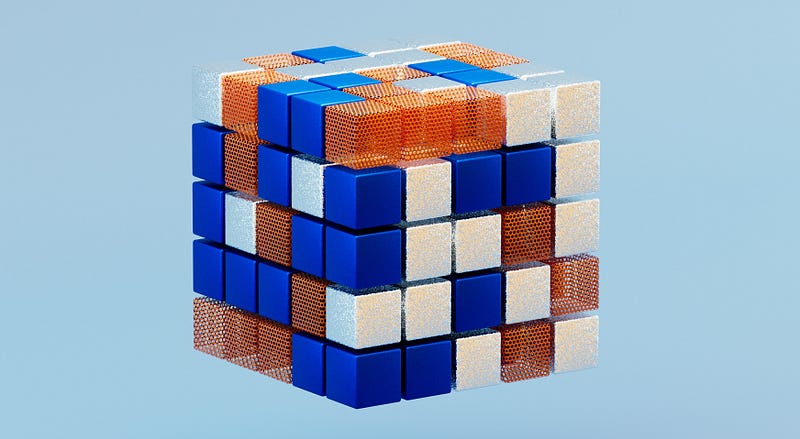
Study Tips to Find Your Focus and Ace Your Next Math Test
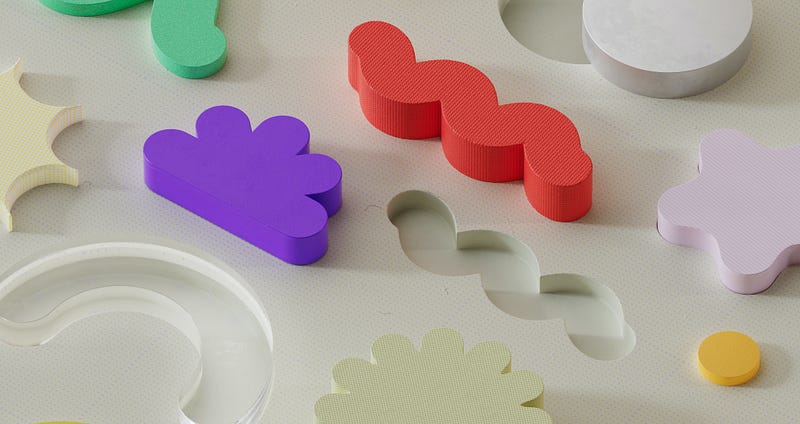
Overcoming Math Anxiety: How to Conquer Fear & Build Confidence

How Photomath Helps with More than Just Homework
Explore your options.
Step-by-step explanations
Custom visual aids
Extra “how” and “why” tips
Deep-dive solutions for hundreds of textbooks
- Start trial
Young Students Gravitate to Math. How Teachers Can Build on That Curiosity

- Share article
Zachary Champagne’s 3rd and 4th graders figure out early on that this math class will be different when their teacher tells them: “I don’t care about the answer.”
The goal is to shift his elementary students’ thinking from some numerical endgame toward the problem-solving process itself. In his more than two decades as a classroom teacher and math researcher, Champagne has found this strategy can be a balm for math anxiety, spur students’ creativity, and pique their curiosity about a subject many find boring and irrelevant.
Telling students the answer doesn’t matter—or throwing it out early on, then working backwards, another of Champagne’s go-to strategies—"can reframe the way we think about mathematics,” said Champagne, who teaches at The Discovery School, a private school in Jacksonville, Fla.

“If we’re thinking about math where the solving is actually the interesting, important part, it frees kids from the stigma of ‘I’m not good at this because I always get things wrong,’” said Champagne, who spent more than a decade working in Florida’s Duval County public schools and served as a math researcher at Florida State University.
This problem-solving or open-ended approach, which emphasizes flexible thinking and real-world situations, is a powerful strategy for engaging the youngest learners in math . Kindergarten through 5th grade is an important time for building students’ skills, confidence, and interest in math—the critical building blocks for middle- and high-school-level math and science, experts say.
Though the approach has been around for decades, districts are striving to incorporate more real-world problem-solving into math class in recent years. California, for instance, recently adopted a controversial framework that puts a heavy emphasis on the approach . And there’s new urgency to get students motivated in math as federal data show students’ math achievement plummeting.
The vast majority of educators—92 percent—say students are more motivated to learn math and science if teachers employ a problem-solving approach, according to a survey of 1,183 district and school leaders and teachers, conducted by the EdWeek Research Center in April. Despite the fact that this approach is highly popular among educators, many have not been trained in how to use it, the same survey found.
Does using real-world problems motivate students?
The Canadian province of Quebec has been using a problem-based approach for decades—and it helps students connect with math and understand how to use it in the real world, said Krista Muis, a professor at McGill University in Montreal, who has studied student perceptions of the teaching strategy.
“When you look at the motivational profiles of students who are just given traditional word problems, or more standard types of math problems, or math content, their motivation is really low when it comes to the value of what they’re learning,” Muis said. “The main question they ask is, ‘why should I care? How is this relevant to me? How am I ever going to use this?’”
But when students tackle common real problems—a favorite of Muis’ asks elementary schoolers to map out the trick-or-treating route that nets the most Halloween candy—they get excited.
“They see the value in it,” Muis said. “And they’re fun problems. They can do them in groups together collaboratively, they can do them individually.”
Quebec students’ higher motivation in math may explain why the province outperforms the rest of Canada—and the United States— on the Trends in International Mathematics and Science Study or TIMMS , Muis said.
In 2019, the most recent year the test was given, Quebec’s 4th graders didn’t perform statistically differently from their U.S. counterparts in math. But 8th graders from the province scored significantly better than their U.S. peers . One reason may be the increased motivation to learn math that Muis believes stems from exposing students to a problem-solving approach early on.
To be sure, a problem-based or open-ended approach to teaching math is often pitted against more traditional, procedural methods—think of the math worksheets full of equations without context.
But many experts and educators see value in exposing students to both strategies.
“I think, really, these things can mutually support one another. And both are necessary,” said Julia Aguirre, a professor and the faculty director of teacher certification programs at the University of Washington Tacoma. “I think we can all agree that a math class that’s only about worksheets would not be a very fulfilling or interesting math class.”
Promote young students’ natural curiosity and creativity
The approach is most effective when teachers apply it to students’ existing interests.
That’s especially important for elementary school students, who start school with a natural curiosity that often dissipates by the time they get to high school, said Molly Daley, a regional math coordinator for Education Service District 112, which serves about 30 districts near Vancouver, Wash.
Thinking about “math is a universal human behavior, and people of all ages engage in math for their own purposes,” Daley said.
Students are using math when they play games and make crafts, she said, or even just look at the landscape.
For instance, a preschool teacher might take a picture of the classroom shoe rack and ask students questions like: How many shoes are there? What patterns do you notice? What shapes do you see?
“If we can honor the math that kids are doing beyond the classroom, then we’re more likely to create a mathematical connection and really allow every person to see how math is not just useful but enjoyable,” Daley said.
In Champagne’s mixed age classroom of 3rd and 4th graders in Florida—which he co-teaches with another educator—students turn to math early in the day, the time when younger students tend to be most able to focus on the subject, in Champagne’s view.
Champagne typically kicks off with a 10- or 15-minute math routine as a warm-up. That might be a “number talk” in which Champagne will put an equation on the board, say 29 plus 15, and then students will solve the problem in their heads.
They’ll spend the next few minutes comparing strategies for finding a solution. One student might have added 30 plus 15 and subtracted one, while another might have added 9 and 5, then 30.
The exercise is aimed at promoting flexibility and the idea that there are multiple ways to solve a problem, Champagne said. It lets students know: “I don’t have to revert to just one strategy. I can think about it in different ways,” he said. The idea is to gives students a chance to use their creative thinking skills in math class.
Students still learn the basics, but lessons are structured so that students can see how seemingly simple problems play out in different, real-world contexts. For instance, if students are learning about dividing with remainders, they may consider how four people can share 31 balloons. In that case, each person gets seven balloons, with three left over.
But what if it were 31 dollars instead of balloons? How does that change the answer? Or what if 31 people needed to get somewhere in four cars? How could they divide up?
Problems can also get more complex—and interdisciplinary—as students advance in elementary school.
Teachers need more training in the problem-solving approach
Tackling big problems with no clear answer is another way to engage elementary school students in math.
Last school year, Aguirre worked with Janaki Nagarajan’s 3rd graders outside Seattle on a project involving a real-life problem with salmon the students had raised and planned to release.
Inexplicably, the fish began dying. So Nagarajan’s students used mathematical modeling to estimate how quickly they were losing salmon, answering questions like: Will we have enough salmon for each student on release day? What can we do if we don’t? Students worked on the problem in groups, and then presented their answers. The class voted on the solution they thought would work best.
The project was “really engaging,” said Nagarajan. She believes that students will be motivated to learn math if they “feel the skills have some purpose outside the classroom.”
But she thinks that many teachers don’t know how common procedures learned in math class could be applied in the real world, so they struggle to make those connections for their students.
Nagarajan began teaching in Renton, a different, Seattle-area school district this school year, largely because it provides more support for teachers to use the real-world problem-solving approach in elementary school math.
Though the approach was encouraged in her previous school, Nagarajan said her new district uses a curriculum that embraces problem-solving and provides coaches who can help her implement the strategy.
Professional development in the problem-solving approach remains uneven. About one in five educators said they “completely agree” that their districts have offered deep and sustained professional development into how to teach math and science from a problem-solving perspective, while just over 40 percent said they disagree—at least somewhat—that they’ve been offered that level of support.
That professional development can be particularly important for elementary school teachers who typically “aren’t math specialists, right? They are generalists,” said Muis of McGill University. “Often, teachers who are not comfortable with mathematics don’t necessarily understand it fully themselves. And so when you bring in complexity that scares them. And then you see teachers kind of stepping back going, ‘I can’t really teach this, I don’t really know what I’m doing.’”
And the approach requires teachers to respond to what students see or notice, which can be stressful for some, Daley said.
“We can get too hyper focused on ‘this is my goal’” in a particular lesson, she said. That can look like: “We’re learning about fractions, but the student made a comment about multiplication. I gotta ignore that.’”
Teachers need to learn not to be afraid if students go off script, Daley said. A problem-solving approach is about “creating more space for students’ ideas and students’ thinking versus just letting your own dominate.”
Making that shift isn’t easy. But if teachers are successful, they positively shape their students’ relationship with math, potentially for years, Daley said.
“Especially with younger learners, when we’re following their lead, that’s how we’re going to tap into their connection and their motivation to engage with math and build up their sense of themselves as a mathematician,” she said.
Coverage of problem solving and student motivation is supported in part by a grant from The Lemelson Foundation, at www.lemelson.org . Education Week retains sole editorial control over the content of this coverage.

Sign Up for EdWeek Update
Edweek top school jobs.


Sign Up & Sign In


- Conversations
- Entrepreneurship

Find Joy in Numbers with This Diverse, Proven Approach to Learning Math
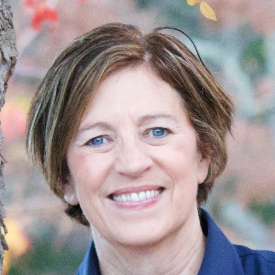
Jo Boaler is a professor at Stanford University and co-founder of youcubed and Struggly. She is formerly the Marie Curie Professor of Mathematics Education for England, a mathematics teacher in London comprehensive schools, and a researcher at King’s College, London.
Below, Jo shares five key insights from her new book, Math-ish: Finding Creativity, Diversity, and Meaning in Mathematics . Listen to the audio version—read by Jo herself—in the Next Big Idea App.
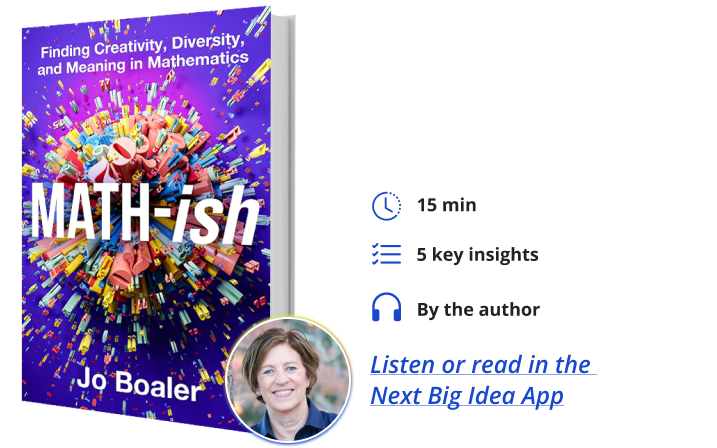
1. Struggle and mistakes make our brains grow.
Before getting into any math, let’s explore some important ideas for approaching learning and life. Neuroscientists at Stanford are revealing fascinating insights into how our brains process math and other things. One of the most surprising and interesting facts is that struggling and making mistakes are the best times for our brains. As one neuroscientist said to me, “If you are not struggling, you are not learning.” Generally, though, people everywhere feel bad about times of struggle.
When I teach Stanford undergraduates, doctoral students, or school children, I share with them that mistakes and times of struggle should be celebrated! They are when our brains are on fire with connectivity, growth, and strengthening. Often, I also share with them the story of a famous mistake.
Fermat’s Last Theorem was named after a French mathematician, Pierre de Fermat.
We know in mathematics that 3 2 + 4 2 = 5 2 . Fermat made a bold claim—he said that a similar expression could never work with an exponent higher than two, and he had a marvelous proof that it would never work—but he did not share the proof. This set mathematicians on a quest to find the proof for hundreds of years.
“There is value in mistakes and during the times when our brains are struggling.”
It was more than 350 years later that a proof was found by the English mathematician Andrew Wiles. Wiles chose to share his proof at The Isaac Newton Institute in Cambridge, England. Rumor had got out that Fermat’s Last Theorem may have been solved, and the room was packed with over 200 mathematicians and journalists. Wiles presented his work over three different lectures. When he finished, the room erupted into applause. Over the next few weeks, it transpired that there was a mistake in his proof, and Wiles went back to his study to work for a few more months before he came up with an accurate proof.
This is an interesting story in itself. It highlights that important mathematical work is not about speed, which is a critical message for people. Something else I always highlight is that the mistakes that Wiles put forward have now produced new fields of mathematics, including parts of algebra. As Peter Brown said, “Out of the ruins of these failures rose deep theories that opened up vast new areas of mathematics.”
There is value in mistakes and during the times when our brains are struggling. That is when brains are strengthening and growing. That message is important not just for students in school but for all of us and in all of our lives. When learning anything, you should want to be on the edge of your understanding, making mistakes, correcting them, and making more. That edge is where the greatest knowledge development and creativity happen.
2. The way you approach learning and life matters.
People think that if you are asked to answer a math question, or any kind of question, you either have knowledge or you don’t. But there is so much more going on in our brains. Successful people are not usually those with more knowledge; they have developed particular ways of working.
It all starts with metacognition. People think metacognition is thinking about your own thinking. Although that is part of it, there are actually four different aspects of m-cog. When we take them on, we become better problem solvers, communicators, and questioners. We become more motivated, develop better relationships, and become more successful in our jobs.
A person who has learned a metacognitive approach is likely to be inquisitive and curious, and they appreciate diverse viewpoints, which is so important in the world right now. Importantly, they enjoy the process of problem-solving and learning. This complex combination of high-level problem-solving, mindset, and planning occurs when we are metacognitive in the anterior prefrontal cortex of our brains.
The first aspect of metacognition starts with self-belief. That means you know you can solve the problem with effort and work because mindset is part of metacognition.
“It all starts with metacognition.”
The second aspect of metacognition is employing different strategies. These strategies include taking a step back and reading the problem out loud, drawing the problem, simplifying it, or trying a smaller case. Students in math classes are rarely taught these strategies, but they usually make the difference between being successful and unsuccessful with problems.
The third aspect is tracking progress. Metacognitive people think about what they have achieved and what they need to achieve. They may use journaling or sketch-noting, both of which help encourage metacognition.
Finally, and perhaps most importantly, a metacognitive person is self-reflective. They ask themselves why something works or is the way it is.
All of these metacognitive ways of being can be learned. If you take on these approaches when facing problems—in learning or life—you will be more successful, whatever knowledge you have.
3. Math-ish.
Numbers are everywhere in the world, and we all use them, in some form, every day of our lives. But there is something interesting about our everyday use of numbers, as in almost every number question we solve, we give -ish answers. For example: How much of the moon can we see tonight? How long is the drive to the airport? How old are you? How much rain fell last night? How many people live in the United States? How long is London Bridge? How much paint do I need to paint the wall?
Additionally, every shape in the world is an -ish shape; there is no perfect circle, rectangle, or square. But math classrooms are all about precision. About 80 percent of questions we answer in the world have -ish answers (that is an ish answer), but in classrooms, about 99 percent are precise. That is out of balance, and I urge us to get in balance.
Teachers everywhere say that students do not have a good sense of numbers, and they get lost in calculations with no idea of what the answer should be. A national standardized question gave 7/8 + 12/13 and asked people to estimate the answer. We know 7/8 is almost 1 and 12/13 is almost 1, so a good estimate would be 2.
They gave possible answers of 1, 2, 19 or 21. The most common answer from US 17-year-olds was 19, followed by 21. Students make those mistakes because they are never asked to -ish answers. They have not developed number sense, and they get lost inside manipulating numbers. When you -ish an answer, your brain stays at an important place. You think about the concept of a number, and you develop number sense.
There are other important reasons for -ishing answers. Many students and adults are afraid of math. What they are afraid of is being wrong. Asking students to -ish numbers releases them from that fear. I have seen that in classrooms and videos on my Mathish website. Teachers ask students for their -ish answers, and hands go up all over the room. Even the shyest and most disengaged student is willing to share their -ish answers.
“About 80 percent of questions we answer in the world have -ish answers.”
I propose that before any student or person works on a calculation or mathematics problem, they think about the answer and come up with an -ish answer. This isn’t limited to number questions either. Before drawing a graph, try to imagine what it will look like. It will cause your brain to pull back from the detailed focus and move into a different mode, thinking conceptually, which is really important.
Some people ask me how asking students to -ish numbers is different from asking them to estimate. They are the same thing, but with an important language change. When we ask students to estimate, they think they are being asked to perform another mathematical method. Often, they calculate precisely and round it off to make it look like an estimate. But when we ask students to -ish numbers, they feel free. They are more willing to share their ideas and, at the same time, develop a number sense.
Taking an -ish perspective is freeing in many parts of life and it does something important for your brain. As you go about the world to -ish numbers, you will not only feel freer, but you will be doing something really important for your brain.
4. We can learn better through mathematical diversity.
The way we all function in the world is by making mental models of it. For example, if I asked you to think of a stapler, you can probably think about what one looks like, the sound a stapler makes, the feel of a stapler in your hand, and the way a stapler changes when you interact with it. Your brain has built a model of a stapler, which is stored in your neocortex, a large and important part of your brain.
It turns out that when we learn, we are helped by building mental models of ideas. Your brain returns to these models when it needs to use knowledge. There are parts of your own learning where you built rich mental models that you can still use and remember. Anything in math can be learned as a visual or physical model that students can see, feel, move around, and interact with.
When you learned about square numbers and square roots, did you draw and build squares and feel them? Did you move them around in your hands? When you considered square roots, did you physically or visually find the diagonals of squares? When you learned about cube numbers, did you build cubes? Did you touch and feel them to see their features and build a mental model of what it means to be cubic? It is likely that you didn’t, so you probably did not develop the mental models you needed. You probably just have a few memories of numbers. Everything can be experienced visually and physically, including algebra.
Neuroscience also tells us we have five brain pathways that can be used when thinking about math. At the back of our heads are two important visual pathways. The most successful people in the world are those who have more communication between different brain pathways. They have interconnected brains. These interconnections build when we don’t just experience math as numbers, but we see it visually, build it, move to show the ideas, and use words to describe it. Interconnections happen when we experience math multidimensionally.
5. Math has a rich cultural history in the world.
Few people learn about the history of numbers, but if they did, they would learn that the first quantitative records in the world came from the Brazilian Amazon. Paintings, created by Indigenous artists more than 10,000 years ago, show “x” marks, counting days, moons, and other cycles. The ancient people of Brazil were paying attention to quantities, now thought to be the first prehistoric numerals.
“These decisions have remained and are why we have 12 hours in a day.”
In a small Congolese area of Africa, a bone was found that has fascinated historians over the generations. It is called the Ishango bone, and it has deep mathematical significance. The Ishango bone is considered to be 20 millennia old and has a set of markings that reveal awareness of prime numbers and the decimal system. The first indications of these important parts of our number system came from central Africa.
Sumer is the earliest known civilization that lived in the region of what was called Mesopotamia, now “the land between the rivers” in Iraq. Later, the Babylonians lived in the same region, and it is the Sumerians and Babylonians who are credited as being the first users of algebra. The word algebra comes from the Arabic: Al-Jabr, meaning the reunion of broken parts. Moving through time, the number system we know and use in the West comes from the Arabic system, which, in turn, came from the Indian system. Scholars in India invented the number zero.
One of the first uses of numbers is shown in the recording of time. People wonder why our system of recording time is in units of 12 or 24 (hours) and the answer is that it comes from the ancient Egyptians, who developed sundials more than 3,000 years ago. The decision to divide the day into 12 units came from the shade they could see on sundials. They saw 10 units from sunrise to sunset and then added a unit for dawn and another for twilight. These decisions have remained and are why we have 12 hours in a day.
When we look at the rich cultural history of mathematics, we see mathematical diversity – as mathematics itself is beautifully diverse. It draws from the rich diversity of people across the world, and it is part of our culture.
To listen to the audio version read by author Jo Boaler, download the Next Big Idea App today:

Download the Next Big Idea App

Also in Magazine

Our theory of the universe may need rewriting.

These drugs are for your brain, not your gut.

The fall of Roe has affected every state in America, even those that protect the right to abortion.
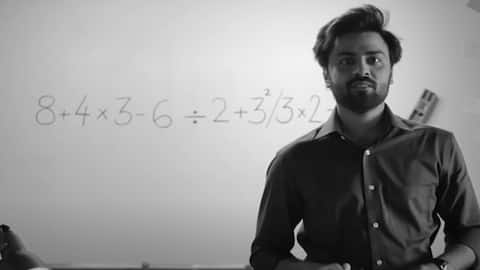
Solve math problem to know 'Kota Factory 3' release date
Actor Jitendra Kumar announced the release date for the eagerly awaited third season of his popular series, Kota Factory , creatively on Thursday. In a departure from convention, Kumar, who plays a teacher on the show, has challenged viewers to solve a math problem to reveal the premiere date. This novel approach has ignited excitement across social media platforms, with fans eagerly trying to solve the mathematical puzzle. Many have already cracked it and identified June 20 as the launch date.
Did you try solving the equation?
Kumar, reprising his role as Jeetu Bhaiya , released an announcement video on YouTube where he is seen writing a math equation on a board. He then encourages fans to solve this equation to find out the release date of the new season. The video, however, did not provide any additional details about the upcoming season. This unique method of revealing the premiere date has further increased anticipation for Kota Factory Season 3 among its viewers.
A glimpse into the background of 'Kota Factory'
Kota Factory is an observational comedy set in Kota , Rajasthan . The series is known for its sharp humor and the relatable existential struggles faced by its protagonists. The narrative follows Vaibhav, a 16-year-old preparing for the Joint Entrance Exam (JEE) at a coaching center in Kota. The show first premiered on TVF Play and YouTube in 2019 before being acquired by Netflix India for its second season in 2021.
Kumar recently graced screens with another popular series
In addition to Kota Factory , Kumar is also recognized for his role in another popular OTT series, Panchayat 3 . The third season of this series was released on Amazon Prime Video on May 28 and has received an overwhelming response from viewers. Interestingly, the show's director Deepak Kumar Mishra confirmed that Seasons 4 and 5 of Panchayat will also come. A great time to be a Kumar fan!
- Share full article
Advertisement
Supported by
The Algebra Problem: How Middle School Math Became a National Flashpoint
Top students can benefit greatly by being offered the subject early. But many districts offer few Black and Latino eighth graders a chance to study it.

By Troy Closson
From suburbs in the Northeast to major cities on the West Coast, a surprising subject is prompting ballot measures, lawsuits and bitter fights among parents: algebra.
Students have been required for decades to learn to solve for the variable x, and to find the slope of a line. Most complete the course in their first year of high school. But top-achievers are sometimes allowed to enroll earlier, typically in eighth grade.
The dual pathways inspire some of the most fiery debates over equity and academic opportunity in American education.
Do bias and inequality keep Black and Latino children off the fast track? Should middle schools eliminate algebra to level the playing field? What if standout pupils lose the chance to challenge themselves?
The questions are so fraught because algebra functions as a crucial crossroads in the education system. Students who fail it are far less likely to graduate. Those who take it early can take calculus by 12th grade, giving them a potential edge when applying to elite universities and lifting them toward society’s most high-status and lucrative professions.
But racial and economic gaps in math achievement are wide in the United States, and grew wider during the pandemic. In some states, nearly four in five poor children do not meet math standards.
To close those gaps, New York City’s previous mayor, Bill de Blasio, adopted a goal embraced by many districts elsewhere. Every middle school would offer algebra, and principals could opt to enroll all of their eighth graders in the class. San Francisco took an opposite approach: If some children could not reach algebra by middle school, no one would be allowed to take it.
The central mission in both cities was to help disadvantaged students. But solving the algebra dilemma can be more complex than solving the quadratic formula.
New York’s dream of “algebra for all” was never fully realized, and Mayor Eric Adams’s administration changed the goal to improving outcomes for ninth graders taking algebra. In San Francisco, dismantling middle-school algebra did little to end racial inequities among students in advanced math classes. After a huge public outcry, the district decided to reverse course.
“You wouldn’t think that there could be a more boring topic in the world,” said Thurston Domina, a professor at the University of North Carolina. “And yet, it’s this place of incredibly high passions.”
“Things run hot,” he said.
In some cities, disputes over algebra have been so intense that parents have sued school districts, protested outside mayors’ offices and campaigned for the ouster of school board members.
Teaching math in middle school is a challenge for educators in part because that is when the material becomes more complex, with students moving from multiplication tables to equations and abstract concepts. Students who have not mastered the basic skills can quickly become lost, and it can be difficult for them to catch up.
Many school districts have traditionally responded to divergent achievement levels by simply separating children into distinct pathways, placing some in general math classes while offering others algebra as an accelerated option. Such sorting, known as tracking, appeals to parents who want their children to reach advanced math as quickly as possible.
But tracking has cast an uncomfortable spotlight on inequality. Around a quarter of all students in the United States take algebra in middle school. But only about 12 percent of Black and Latino eighth graders do, compared with roughly 24 percent of white pupils, a federal report found .
“That’s why middle school math is this flashpoint,” said Joshua Goodman, an associate professor of education and economics at Boston University. “It’s the first moment where you potentially make it very obvious and explicit that there are knowledge gaps opening up.”
In the decades-long war over math, San Francisco has emerged as a prominent battleground.
California once required that all eighth graders take algebra. But lower-performing middle school students often struggle when forced to enroll in the class, research shows. San Francisco later stopped offering the class in eighth grade. But the ban did little to close achievement gaps in more advanced math classes, recent research has found.
As the pendulum swung, the only constant was anger. Leading Bay Area academics disparaged one another’s research . A group of parents even sued the district last spring. “Denying students the opportunity to skip ahead in math when their intellectual ability clearly allows for it greatly harms their potential for future achievement,” their lawsuit said.
The city is now back to where it began: Middle school algebra — for some, not necessarily for all — will return in August. The experience underscored how every approach carries risks.
“Schools really don’t know what to do,” said Jon R. Star, an educational psychologist at Harvard who has studied algebra education. “And it’s just leading to a lot of tension.”
In Cambridge, Mass., the school district phased out middle school algebra before the pandemic. But some argued that the move had backfired: Families who could afford to simply paid for their children to take accelerated math outside of school.
“It’s the worst of all possible worlds for equity,” Jacob Barandes, a Cambridge parent, said at a school board meeting.
Elsewhere, many students lack options to take the class early: One of Philadelphia’s most prestigious high schools requires students to pass algebra before enrolling, preventing many low-income children from applying because they attend middle schools that do not offer the class.
In New York, Mr. de Blasio sought to tackle the disparities when he announced a plan in 2015 to offer algebra — but not require it — in all of the city’s middle schools. More than 15,000 eighth graders did not have the class at their schools at the time.
Since then, the number of middle schools that offer algebra has risen to about 80 percent from 60 percent. But white and Asian American students still pass state algebra tests at higher rates than their peers.
The city’s current schools chancellor, David Banks, also shifted the system’s algebra focus to high schools, requiring the same ninth-grade curriculum at many schools in a move that has won both support and backlash from educators.
And some New York City families are still worried about middle school. A group of parent leaders in Manhattan recently asked the district to create more accelerated math options before high school, saying that many young students must seek out higher-level instruction outside the public school system.
In a vast district like New York — where some schools are filled with children from well-off families and others mainly educate homeless children — the challenge in math education can be that “incredible diversity,” said Pedro A. Noguera, the dean of the University of Southern California’s Rossier School of Education.
“You have some kids who are ready for algebra in fourth grade, and they should not be denied it,” Mr. Noguera said. “Others are still struggling with arithmetic in high school, and they need support.”
Many schools are unequipped to teach children with disparate math skills in a single classroom. Some educators lack the training they need to help students who have fallen behind, while also challenging those working at grade level or beyond.
Some schools have tried to find ways to tackle the issue on their own. KIPP charter schools in New York have added an additional half-hour of math time to many students’ schedules, to give children more time for practice and support so they can be ready for algebra by eighth grade.
At Middle School 50 in Brooklyn, where all eighth graders take algebra, teachers rewrote lesson plans for sixth- and seventh-grade students to lay the groundwork for the class.
The school’s principal, Ben Honoroff, said he expected that some students would have to retake the class in high school. But after starting a small algebra pilot program a few years ago, he came to believe that exposing children early could benefit everyone — as long as students came into it well prepared.
Looking around at the students who were not enrolling in the class, Mr. Honoroff said, “we asked, ‘Are there other kids that would excel in this?’”
“The answer was 100 percent, yes,” he added. “That was not something that I could live with.”
Troy Closson reports on K-12 schools in New York City for The Times. More about Troy Closson
- Today's news
- Reviews and deals
- Climate change
- 2024 election
- Fall allergies
- Health news
- Mental health
- Sexual health
- Family health
- So mini ways
- Unapologetically
- Buying guides
Entertainment
- How to Watch
- My watchlist
- Stock market
- Biden economy
- Personal finance
- Stocks: most active
- Stocks: gainers
- Stocks: losers
- Trending tickers
- World indices
- US Treasury bonds
- Top mutual funds
- Highest open interest
- Highest implied volatility
- Currency converter
- Basic materials
- Communication services
- Consumer cyclical
- Consumer defensive
- Financial services
- Industrials
- Real estate
- Mutual funds
- Credit cards
- Balance transfer cards
- Cash back cards
- Rewards cards
- Travel cards
- Online checking
- High-yield savings
- Money market
- Home equity loan
- Personal loans
- Student loans
- Options pit
- Fantasy football
- Pro Pick 'Em
- College Pick 'Em
- Fantasy baseball
- Fantasy hockey
- Fantasy basketball
- Download the app
- Daily fantasy
- Scores and schedules
- GameChannel
- World Baseball Classic
- Premier League
- CONCACAF League
- Champions League
- Motorsports
- Horse racing
- Newsletters
New on Yahoo
- Privacy Dashboard
The Algebra Problem: How Middle School Math Became a National Flashpoint
From suburbs in the Northeast to major cities on the West Coast, a surprising subject is prompting ballot measures, lawsuits and bitter fights among parents: algebra.
Students have been required for decades to learn to solve for the variable x, and to find the slope of a line. Most complete the course in their first year of high school. But top-achievers are sometimes allowed to enroll earlier, typically in eighth grade.
The dual pathways inspire some of the most fiery debates over equity and academic opportunity in American education.
Sign up for The Morning newsletter from the New York Times
Do bias and inequality keep Black and Latino children off the fast track? Should middle schools eliminate algebra to level the playing field? What if standout pupils lose the chance to challenge themselves?
The questions are so fraught because algebra functions as a crucial crossroads in the education system.
Students who fail it are far less likely to graduate. Those who take it early can take calculus by 12th grade, giving them a potential edge when applying to elite universities and lifting them toward society’s most high-status and lucrative professions.
But racial and economic gaps in math achievement are wide in the United States, and grew wider during the pandemic. In some states, nearly 4 in 5 poor children do not meet math standards.
To close those gaps, New York City’s previous mayor, Bill de Blasio, adopted a goal embraced by many districts elsewhere. Every middle school would offer algebra, and principals could opt to enroll all of their eighth graders in the class.
San Francisco took an opposite approach: If some children could not reach algebra by middle school, no one would be allowed to take it.
The central mission in both cities was to help disadvantaged students. But solving the algebra dilemma can be more complex than solving the quadratic formula.
New York’s dream of “algebra for all” was never fully realized, and Mayor Eric Adams’ administration changed the goal to improving outcomes for ninth graders taking algebra. In San Francisco, dismantling middle-school algebra did little to end racial inequities among students in advanced math classes. After a huge public outcry, the district decided to reverse course.
“You wouldn’t think that there could be a more boring topic in the world,” said Thurston Domina, a professor at the University of North Carolina. “And yet, it’s this place of incredibly high passions.”
“Things run hot,” he said.
In some cities, disputes over algebra have been so intense that parents have sued school districts, protested outside mayors’ offices and campaigned for the ouster of school board members.
Teaching math in middle school is a challenge for educators in part because that is when the material becomes more complex, with students moving from multiplication tables to equations and abstract concepts. Students who have not mastered the basic skills can quickly become lost, and it can be difficult for them to catch up.
Many school districts have traditionally responded to divergent achievement levels by simply separating children into distinct pathways, placing some in general math classes while offering others algebra as an accelerated option. Such sorting, known as tracking, appeals to parents who want their children to reach advanced math as quickly as possible.
But tracking has cast an uncomfortable spotlight on inequality. Around a quarter of all students in the United States take algebra in middle school. But only about 12% of Black and Latino eighth graders do, compared with roughly 24% of white pupils, a federal report found.
“That’s why middle school math is this flashpoint,” said Joshua Goodman, an associate professor of education and economics at Boston University. “It’s the first moment where you potentially make it very obvious and explicit that there are knowledge gaps opening up.”
In the decades-long war over math, San Francisco has emerged as a prominent battleground.
California once required that all eighth graders take algebra. But lower-performing middle school students often struggle when forced to enroll in the class, research shows. San Francisco later stopped offering the class in eighth grade. But the ban did little to close achievement gaps in more advanced math classes, recent research has found.
As the pendulum swung, the only constant was anger. Leading Bay Area academics disparaged one another’s research. A group of parents even sued the district last spring. “Denying students the opportunity to skip ahead in math when their intellectual ability clearly allows for it greatly harms their potential for future achievement,” their lawsuit said.
The city is now back to where it began: Middle school algebra — for some, not necessarily for all — will return in August. The experience underscored how every approach carries risks.
“Schools really don’t know what to do,” said Jon R. Star, an educational psychologist at Harvard who has studied algebra education. “And it’s just leading to a lot of tension.”
In Cambridge, Massachusetts, the school district phased out middle school algebra before the pandemic. But some argued that the move had backfired: Families who could afford to simply paid for their children to take accelerated math outside school.
“It’s the worst of all possible worlds for equity,” Jacob Barandes, a Cambridge parent, said at a school board meeting.
Elsewhere, many students lack options to take the class early: One of Philadelphia’s most prestigious high schools requires students to pass algebra before enrolling, preventing many low-income children from applying because they attend middle schools that do not offer the class.
In New York, de Blasio sought to tackle the disparities when he announced a plan in 2015 to offer algebra — but not require it — in all of the city’s middle schools. More than 15,000 eighth graders did not have the class at their schools at the time.
Since then, the number of middle schools that offer algebra has risen to about 80% from 60%. But white and Asian American students still pass state algebra tests at higher rates than their peers.
The city’s schools chancellor, David Banks, also shifted the system’s algebra focus to high schools, requiring the same ninth-grade curriculum at many schools in a move that has won support and backlash from educators.
And some New York City families are still worried about middle school. A group of parent leaders in Manhattan recently asked the district to create more accelerated math options before high school, saying that many young students must seek out higher-level instruction outside the public school system.
In a vast district like New York — where some schools are filled with children from well-off families and others mainly educate homeless children — the challenge in math education can be that “incredible diversity,” said Pedro A. Noguera, the dean of the University of Southern California’s Rossier School of Education.
“You have some kids who are ready for algebra in fourth grade, and they should not be denied it,” Noguera said. “Others are still struggling with arithmetic in high school, and they need support.”
Many schools are unequipped to teach children with disparate math skills in a single classroom. Some educators lack the training they need to help students who have fallen behind, while also challenging those working at grade level or beyond.
Some schools have tried to find ways to tackle the issue on their own. KIPP charter schools in New York have added an additional half-hour of math time to many students’ schedules, to give children more time for practice and support so they can be ready for algebra by eighth grade.
At Middle School 50 in Brooklyn, where all eighth graders take algebra, teachers rewrote lesson plans for sixth- and seventh-grade students to lay the groundwork for the class.
The school’s principal, Ben Honoroff, said he expected that some students would have to retake the class in high school. But after starting a small algebra pilot program a few years ago, he came to believe that exposing children early could benefit everyone — as long as students came into it well prepared.
Looking around at the students who were not enrolling in the class, Honoroff said, “we asked, ‘Are there other kids that would excel in this?’”
“The answer was 100%, yes,” he added. “That was not something that I could live with.”
c.2024 The New York Times Company
Recommended Stories
Daisy ridley's lips turned blue filming swimming scenes in 'young woman and the sea': 'she's a force of nature'.
The actress and executive producer talked to Yahoo Entertainment about diving headfirst into her role as legendary swimmer Trudy Ederle.
STI-tuned 2025 Subaru WRX tS packs more GT goodies
Subaru is bringing the tS badge to the WRX for 2025. 'Tuned by STI,' it will offer the GT's adaptive dampers and STI-tuned dampers, but no extra boost
Trump trial live updates: 2nd day of deliberations set to begin
The jury continues to deliberate.
YoLa Fresh, a GrubMarket for Morocco, digs up $7M to connect farmers with food sellers
The fresh produce supply chain in Africa and emerging markets is faced with a daily list of cascading challenges. Several agritech startups have tried to solve these issues by taking control of the fresh produce supply chain, bypassing intermediaries, and directly connecting retailers and farmers; Frubana in Latin America, Meicai in China, and Waycool in India are a few examples. YoLa Fresh is one such startup that directly connects smallholder farmers with traditional retailers of fruits and vegetables, starting with Morocco.
'My videos are loading so fast': Grab this Apple iPad for just $300 — and other eye-popping deals today
Also on our cheat sheet: Big savings on Samsonite, Instant Pot, Hanes and more!
Joe West thinks outgoing umpire Ángel Hernández got 'a raw deal,' was 'good at' his job
West can probably empathize with what Hernández might be going through if Hernández is paying attention to the noise this week.
FHA cash-out refinance: Requirements and guidelines
An FHA cash-out refinance lets you refinance into a new FHA loan and tap into your home equity to receive cash. Learn if you qualify for an FHA cash-out refi.
The women in AI making a difference
To give AI-focused women academics and others their well-deserved -- and overdue -- time in the spotlight, TechCrunch is launching a series of interviews focusing on remarkable women who've contributed to the AI revolution. In a New York Times piece late last year, the Gray Lady broke down how the current boom in AI came to be -- highlighting many of the usual suspects like Sam Altman, Elon Musk and Larry Page. It began long before that, with academics, regulators, ethicists and hobbyists working tirelessly in relative obscurity to build the foundations for the AI and generative AI systems we have today.
Top car colors for 2024? 'Colorful cars appear to be an endangered species'
Grays of various shades — white, black and gray itself — are dominant in the automotive colors landscape, while cars that are deemed “colorful” — blues and reds, golds and browns — continue to plummet in popularity, according to a recent data analysis by ISeeCars.com.
The best MagSafe battery packs for 2024 to keep your phone charged all day
If you own an iPhone, be sure to pack one of these magnetic mobile chargers.
Google’s generative AI fails 'will slowly erode our trust in Google'
Google's generative AI flubs could erode consumer trust in the company that's synonymous with finding accurate information online.
MLB integrates Negro Leagues stats in historic move, Angel Hernandez retires, Craig Counsell returns
Jake Mintz is joined by Russell Dorsey to talk about the historic integration of Negro League stats into the Major League record book. Later, Jake is joined by Bailey Freeman to discuss Angel Hernandez retiring & Craig Counsell’s return to Milwaukee.
Fantasy football metronome Mike Evans still a ridiculous draft value after a decade of production
Andy Behrens dives into the disrespect one of the most consistent receivers of all time is getting in early fantasy football drafts.
'A dramatic difference every time': This No. 1 bestselling Crest teeth-whitening kit is down to $30
Take it from one of 65,000 smiling five-star reviewers: 'They actually work, y'all!'
What Elon Musk should tell Donald Trump
The EV billionaire is a new Trump adviser. Here's how he could help Trump freshen his thinking on electric vehicles.
2025 Cadillac Optiq revealed as entry-level EV for North America
Cadillac has pulled the wraps off its compact luxury EV, the Optiq, which slots below the Lyriq in the lineup. It offers standard AWD and Super Cruise.
This hairstylist-approved dryer that's 'better than a Dyson' is only $36 at Walmart — a cool 70% off
One professional stylist-reviewer raves: 'Works just as well as the $400 one for a tenth of the price.'
How to choose between a single-family vs. multifamily home
When deciding between a single-family vs. multifamily home, consider your budget and how much privacy you want. Learn which type of home is the right fit.
Limited-edition Audi RS4 gets more power and throwback Imola Yellow paint
Audi is celebrating 25 years of the RS4 Avant with a limited-edition model that gets more power and a specific design. The wagon is limited to 250 units.
Here's what Yahoo's shopping editors snagged during Memorial Day sales (most deals are still live!)
Score up to 65% off everything from warm-weather fashion and beauty finds to Apple watches and air purifiers.
Mathway: Math Problem Solver 4+
Homework scanner & calculator, chegg, inc..
- #66 in Education
- 4.8 • 5.4K Ratings
- Offers In-App Purchases
Screenshots
Description.
With millions of users and billions of problems solved, Mathway is the world's #1 math problem solver. From basic algebra to complex calculus, Mathway instantly solves your most difficult math problems. Simply type your problem in (or point your camera and snap a pic!) to receive instant free answers. Need detailed step-by-step solutions? Mathway is like a private tutor in the palm of your hand, providing instant homework help anywhere, anytime. Mathway covers all levels of math, including: Basic math/pre-algebra (arithmetic, integers, fractions, decimal numbers, roots, factors and more. . .) Algebra (linear equations/inequalities, quadratic equations/inequalities, absolute equations/inequalities, systems of equations, logarithms, functions, matrices, graphing and more. . .) Trigonometry/precalculus (trigonometric functions, identities, conic sections, vectors, matrices, complex numbers, sequences and series and more. . .) Calculus (limits, derivatives, integrals and more. . .) Statistics (probability, permutations, combinations and more. . .) Got a math problem? Just ask Mathway. "Easy to use and efficient, Mathway appeals to anyone who needs help solving mathematical problems, whether we're talking about high school students or undergraduates." - Yahoo! News "If you've got some math problems that need solving, check out Mathway. This tool will show you how it reached its answer, letting you learn from the process." - CNET "Mathway is an irreplaceable tool when it comes to problem solving. The app helps you do your math homework. Not only does it do your assignment for you, it teaches you how to do it right. All you have to do is put the equation in and press the Enter button." - Lifehack Mathway provides answers to your problems completely free of charge. For step-by-step solutions, an optional monthly or annual subscription is available. In addition, Mathway offers an optional live tutoring subscription upgrade that provides access to a live tutor anytime you need additional help. If a premium subscription option is selected: Payment will be charged to iTunes account at confirmation of purchase. Subscription automatically renews unless auto-renew is turned off at least 24 hours before the end of the current period. Account will be charged for renewal within 24 hours prior to the end of the current period, at the same monthly or annual rate selected at the beginning of the subscription. Subscriptions may be managed by the user and auto-renewal may be turned off by going to the user's account settings after purchase. Terms of Use: https://www.mathway.com/terms Privacy Policy: https://www.mathway.com/privacy
Version 5.5.6
Powered by Chegg, Mathway is your one-stop shop for homework help. Is your equation too complex to type? Save time with our snap and solve feature! Just take a photo and instantly see the solution. Our interactive calculator also allows you to select your class subject (now including physics!) to generate all the functions you need to solve that equation. Need more than an answer? Upgrade your subscription and get unlimited access to detailed equation breakdowns, helping you learn how to solve it one step at a time.
Ratings and Reviews
5.4K Ratings
Everyone is complaining about the 12$ a month for this app huh? I have paid for this app and I didn’t regret it because the steps were very clear and easy to understand more than my teacher. I could learn with it and also have a tutor on the app for the premium. If you are looking for a free math app that isn’t clear then Mathway is not for you, go build your own free math help app as good as this and make it free it’s not your app and you have no right to tell the developers how to run their app because they spend time and money developing this app, I am a software developer and it’s not easy. I used this app in grade 11 to grade 12 and used it in my first semester in college and it was a great help for assignment and studying.
Best app but steps should be free
Nice app for homework but plz don’t ask for money
scam since you have to pay 12 $ for steps
App Privacy
The developer, Chegg, Inc. , indicated that the app’s privacy practices may include handling of data as described below. For more information, see the developer's privacy policy .
Data Used to Track You
The following data may be used to track you across apps and websites owned by other companies:
- Contact Info
- Identifiers
Data Linked to You
The following data may be collected and linked to your identity:
- User Content
Data Not Linked to You
The following data may be collected but it is not linked to your identity:
Privacy practices may vary, for example, based on the features you use or your age. Learn More
Information
English, Arabic, French, German, Hindi, Indonesian, Italian, Japanese, Korean, Portuguese, Russian, Simplified Chinese, Spanish, Turkish, Vietnamese
- Steps (Monthly) $12.99
- Steps (Monthly) $27.99
- Steps (Annual) $51.99
- Steps (Annual) $109.99
- Developer Website
- App Support
- Privacy Policy
More By This Developer
Chegg Study - Homework Helper
You Might Also Like
FastMath - Take Photo & Solve
MathPapa - Algebra Calculator
Cymath - Math Problem Solver
AIR MATH. Homework Helper
Symbolab: AI Math Calculator
Algebra Math Solver
- Sign Up / Log In
Create a free profile to get unlimited access to exclusive show news, updates, and more!
You'll Have No Words Seeing This Precious 2-Year-Old Genius Do Multiplication on AGT
Simon Cowell pleads, “Get us a calculator!” and asks Baby Dev to negotiate his next deal in this incredible AGT Season 19 Audition.

While most toddlers are stacking blocks and coloring with crayons, this pint-sized genius does addition, subtraction, and multiplication on national television.
How to Watch
Watch America’s Got Talent Tuesdays at 8/7c on NBC and next day on Peacock .
Devan is the youngest Act ever to light up the America’s Got Talent stage, and in the Season 19 premiere, we can see why. The sweet boy knocked everyone’s socks off as he sailed through three different math equations that, to be honest, had the Judges stumped .
“We’re all sitting here thinking the same thing: get us a calculator,” said Simon Cowell after the performance, adding, “I now feel really stupid.”
RELATED: Who Are the America's Got Talent Season 19 Judges?
Baby Dev’s father, Duane, a retired police officer, told NBC Insider he noticed something very special about his son early on: “At 4 months old, we realized his love for numbers.”
Duane explained that when he exposed his son to early learning shows, Baby Dev would suddenly cry when they switched away from math. “And when we turned it back, he would stop. We’re like, all right, he has this love and passion for numbers,” he said.
How old is Baby Devan?
Devan is 2 years old, the youngest-ever contestant on AGT .
From the moment Baby Dev fist-bumped Terry Crews backstage before his Season 19 debut, AGT fans were charmed. The precious boy laughed, jumped, and squealed with delight after solving equations and politely saying “hello” and “thank you” to the Judges while on stage with his proud dad.

“His first word before mama and dada was seven,” Duane told the Judges. “That’s my lucky number,” exclaimed Simon. And it seemed to be Baby Dev’s, too. Three whiteboards were set up on stage — two for multiplication and one for addition — with Judges calling out random numbers. When Baby Dev quickly solved 7 x 9, there was a stunned silence before the crowd erupted in applause.
How did Devan develop his math skills?
Duane explained to NBC Insider how he nurtured his son’s penchant for math.
“At age 1, we had bought him a writing tablet. We would practice writing numbers with him from 1 to 10… and we would practice writing every day, and by 15 months old, he knew how to write numbers on his own.” After mastering addition, the math prodigy moved on to subtraction and his times tables.
“We can just be in bed, and he’ll be like… ‘Math, please. I wanna do math, please,’ and then he’ll go to his writing board and just do math equations,” said his dad, who noted that the little boy always loved counting everything. “Cars on the street, birds, trees… he has number magnets that he carries with him like it’s a toy.”
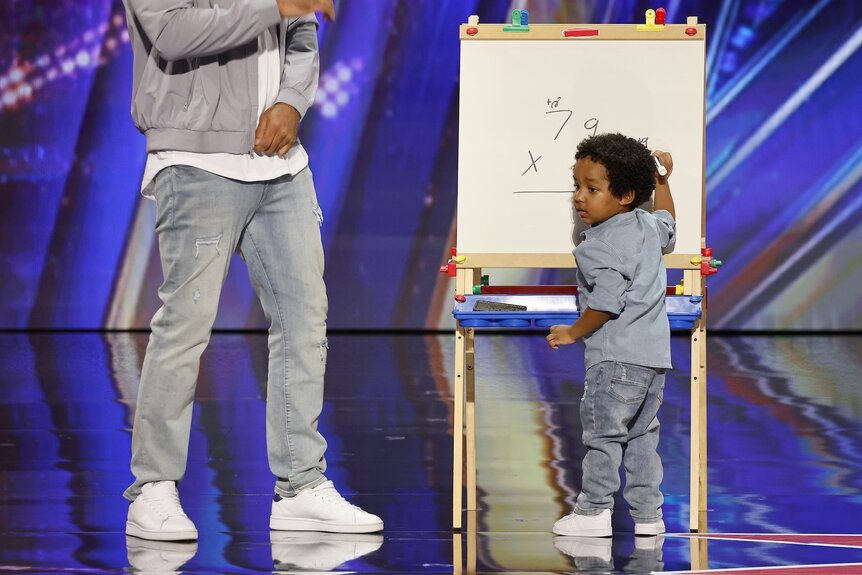
Baby Dev does not receive formal tutoring, and as one audience member pointed out, “He’s not even using his fingers” to count. However, he might have one strict requirement when calculating: Not being interrupted. As Baby Dev tackled a math problem and jotted down numbers, Howie Mandel loudly whispered, “We get to see the process.”
We can just be in bed, and he’ll be like… ‘Math, please. I wanna do math, please!’” Duane, Baby Dev's dad
The toddler shot him a look that could freeze water. After a long pause and some shushing directed toward Mandel, Baby Dev continued on and solved the final equation. He was unanimously voted on to the next round — but he may have something extra on his plate, too.
When Simon asked, “Devon, will you help me negotiate my next deal?” the little cutie responded, “Yes!”
Obviously this charming youngster moved on to the next round of the competition where fans are surely eager to see what mathematical wizardry he'll come up with next.
Watch all-new episodes of America’s Got Talent , airing Tuesdays at 8/7c on NBC and streaming the next day on Peacock .
- Reporting by McKenzie Jean-Philippe
America's Got Talent
- AGT Franchise
- Cast And Show News
- Howie Mandel
- Simon Cowell
- Sofia Vergara
- Terry Crews
Related Stories

Is Chicago P.D. New Tonight? (May 29, 2024)

Is Chicago Fire New Tonight? (May 29, 2024)

What to Know About AGT Country Star Reyna Roberts

Tom Ball's Cover of "Stand by Me," Backed by a Full Choir, Is Pure Magic

Darci Lynne's A Cappella Cover of Etta James' "At Last" Is Earth-Shattering

Why Simon Cowell Wears Those Red Glasses on AGT

Simon Cowell Reveals His Son Eric's Favorite-Ever Act

Simon Cowell Gushes Over Sofía Vergara’s Puppy on AGT

13-Year-Old's Dance Act on AGT 2024 Is "Like the Exorcist"

Every Audition From the AGT Season 19 Premiere: A Recap

A Recap of Every Golden Buzzer on AGT 2024, Season 19

Janitor Richard Goodall Gets Golden Buzzer Singing Journey

Recommended for You

2-Year-Old Mariska Hargitay Appears on the Merv Griffin Show

Ryan Gosling and Jimmy Fallon Deserve Oscars for Playing Identical-Looking Tough Cops

Scarlett Johansson Matches Katie Britt's SOTU Energy in SNL Parody: Watch

IMAGES
VIDEO
COMMENTS
Geometry solver is certified by the Educational App Store and we also won #11 place in Math category in Mobile Learning in Action! - Now with AI assistant that will scan and solve your geometry word problems! - Explore 100+ geometric shapes and study their properties. - Improve your geometry skills with step-by-step solutions.
About this app. arrow_forward. Mathway is the world's smartest math calculator for algebra, graphing, calculus and more! Mathway gives you unlimited access to math solutions that can help you understand complex concepts. Simply point your camera and snap a photo or type your math homework question for step-by-step answers.
Interactive, free online geometry tool from GeoGebra: create triangles, circles, angles, transformations and much more!
About this app. "Geometry" is advanced application for solving geometry problems. There is a complete solution delivered for each issue to satisfy every teacher or student. The application solves every algebraic problem including those with: - fractions - roots - powers you can also use parentheses, decimal numbers and Pi number.
Explore math with our beautiful, free online graphing calculator. Graph functions, plot points, visualize algebraic equations, add sliders, animate graphs, and more.
Screenshots. Solve Geometry Problems with Ease: Our Geometry Solver app provides quick and accurate solutions for calculating perimeter, surface area, and volume of over 110 2D and 3D shapes. Whether it's triangles, circles, spheres, or pyramids, we've got you covered. Export your calculations to photo gallery and share it with your friends.
Get accurate solutions and step-by-step explanations for algebra and other math problems with the free GeoGebra Math Solver. Enhance your problem-solving skills while learning how to solve equations on your own. Try it now! ... Download our apps here:
Get math help in your language. Works in Spanish, Hindi, German, and more. Online math solver with free step by step solutions to algebra, calculus, and other math problems. Get help on the web or with our math app.
Free math problem solver answers your algebra homework questions with step-by-step explanations. Mathway. Visit Mathway on the web. Start 7-day free trial on the app. Start 7-day free trial on the app. Download free on Amazon. Download free in Windows Store. get Go. Algebra. Basic Math. Pre-Algebra. Algebra. Trigonometry. Precalculus. Calculus ...
For a Free Trial, Download The App. Full pad Go. Symbolab, Making Math Simpler Word Problems Provide step-by-step solutions to math word problems Graphing Plot and analyze functions and equations with detailed steps ... Solve geometry problems, proofs, and draw geometric shapes Math Help Tailored For You
Interactive geometry calculator. Create diagrams, solve triangles, rectangles, parallelograms, rhombus, trapezoid and kite problems.
Cymath | Math Problem Solver with Steps | Math Solving App ... \\"Solve
3. Socratic by Google. Socratic is one of the Android apps from Google that you might have never heard of before. It covers math concepts like algebra, geometry, trigonometry, calculus, and more. Apart from mathematics, it can help with various other topics like biology, chemistry, physics, history, and poetry.
Learning geometry can also improve problem-solving and critical thinking abilities, making it a crucial subject for academic success. ... and apps that solve geometry problems to help children learn and understand geometry concepts. Notable Features: Free; Best for kids aged 2 to 7; Support available: Email and help center; The app is available on:
Geometry Solver is a simple-to-use app for solving geometry problems. It covers a variety of 2D and 3D shapes and lets the user enter values for any of the variables. The app then uses these to derive other properties of the shape. As Geometry Solver app is so quick and easy to use, students can easily experiment with how changing one variable ...
Geometry solver that solves problems step by step. More than 20 shapes supported, insert data through gestures or manually.
Monthly. $9.99 USD. Step-by-step explanations. Custom visual aids. Extra "how" and "why" tips. Deep-dive solutions for hundreds of textbooks. Start trial. Solve even complex math problems with Photomath, the top-rated math camera solver app. Download now and understand your math homework step-by-step.
The pathway mathematics problem-solving app works like an algebra calculator, offering instant answers to the most challenging math problems. This app can help you with any math problem, from simple math problems to more complex ones, calculus, trigonometry, algebra, geometry, etc.
Math Message Boards FAQ & Community Help | AoPS. Summer is a great time to explore cool problems and keep your skills sharp! Schedule a class today! Community. E_NOACTION.
The vast majority of educators—92 percent—say students are more motivated to learn math and science if teachers employ a problem-solving approach, according to a survey of 1,183 district and ...
A national standardized question gave 7/8 + 12/13 and asked people to estimate the answer. We know 7/8 is almost 1 and 12/13 is almost 1, so a good estimate would be 2. They gave possible answers of 1, 2, 19 or 21. The most common answer from US 17-year-olds was 19, followed by 21.
May 30, 2024 05:37 pm. What's the story. Actor Jitendra Kumar announced the release date for the eagerly awaited third season of his popular series, Kota Factory, creatively on Thursday. In a ...
Around a quarter of all students in the United States take algebra in middle school. But only about 12 percent of Black and Latino eighth graders do, compared with roughly 24 percent of white ...
Around a quarter of all students in the United States take algebra in middle school. But only about 12% of Black and Latino eighth graders do, compared with roughly 24% of white pupils, a federal ...
Screenshots. With millions of users and billions of problems solved, Mathway is the world's #1 math problem solver. From basic algebra to complex calculus, Mathway instantly solves your most difficult math problems. Simply type your problem in (or point your camera and snap a pic!) to receive instant free answers.
Devan is 2 years old, the youngest-ever contestant on AGT. From the moment Baby Dev fist-bumped Terry Crews backstage before his Season 19 debut, AGT fans were charmed. The precious boy laughed ...